管理学习题
- 格式:doc
- 大小:128.00 KB
- 文档页数:34
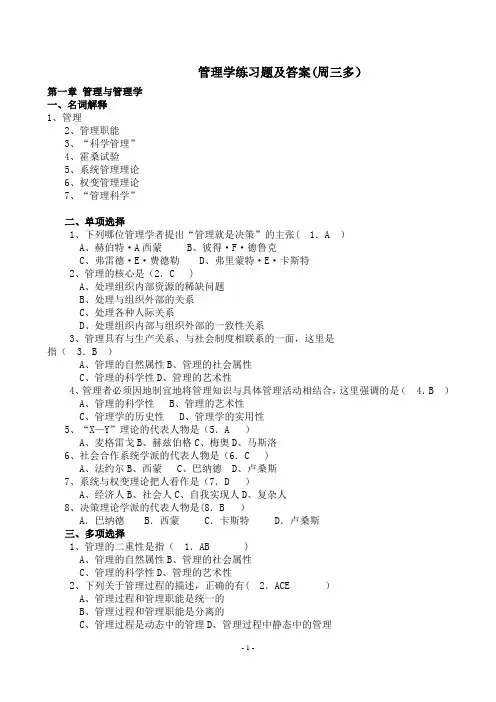
管理学练习题及答案(周三多)第一章管理与管理学一、名词解释1、管理2、管理职能3、“科学管理”4、霍桑试验5、系统管理理论6、权变管理理论7、“管理科学”二、单项选择1、下列哪位管理学者提出“管理就是决策”的主张( 1.A )A、赫伯特·A西蒙B、彼得·F·德鲁克C、弗雷德·E·费德勒D、弗里蒙特·E·卡斯特2、管理的核心是(2.C )A、处理组织内部资源的稀缺问题B、处理与组织外部的关系C、处理各种人际关系D、处理组织内部与组织外部的一致性关系3、管理具有与生产关系、与社会制度相联系的一面,这里是指( 3.B )A、管理的自然属性B、管理的社会属性C、管理的科学性D、管理的艺术性4、管理者必须因地制宜地将管理知识与具体管理活动相结合,这里强调的是( 4.B )A、管理的科学性B、管理的艺术性C、管理学的历史性D、管理学的实用性5、“X—Y”理论的代表人物是(5.A )A、麦格雷戈B、赫兹伯格C、梅奥D、马斯洛6、社会合作系统学派的代表人物是(6.C )A、法约尔B、西蒙C、巴纳德D、卢桑斯7、系统与权变理论把人看作是(7.D )A、经济人B、社会人C、自我实现人D、复杂人8、决策理论学派的代表人物是(8.B )A.巴纳德 B.西蒙 C.卡斯特 D.卢桑斯三、多项选择1、管理的二重性是指( 1.AB )A、管理的自然属性B、管理的社会属性C、管理的科学性D、管理的艺术性2、下列关于管理过程的描述,正确的有( 2.ACE )A、管理过程和管理职能是统一的B、管理过程和管理职能是分离的C、管理过程是动态中的管理D、管理过程中静态中的管理E、管理过程也是信息变换的过程3、管理学具有以下特征:( 3.ABCD )A、一般性B、综合性C、历史性D、实用性E、艺术性4、从科学的定义上讲,存在管理必须具备以下条件:(4.AE )A、必须是两个人以上的集体活动B、必须是具有盈利动机的集体活动C、必须是正式组织D、必须是非正式组织E、必须具有一致认可的、自觉的目标5、赫兹伯格理论中的“双因素”是指( 5.AB )A.保健 B.激励 C.X理论 D.Y理论6、以下哪些内容是法约尔提出的管理原则(6.ABD )A.统一指挥 B.统一领导C.职能管理 D.人员的团结7、“行为科学”的代表人物是( 7.BC )A.德鲁克 B.马斯洛 C.麦格雷戈 D.西蒙8、古典管理理论的代表人物是( 8.AB )A.泰罗 B.法约尔 C.梅奥 D.李嘉图四、填空1、管理二重性是指管理的自然属性和管理的社会属性。
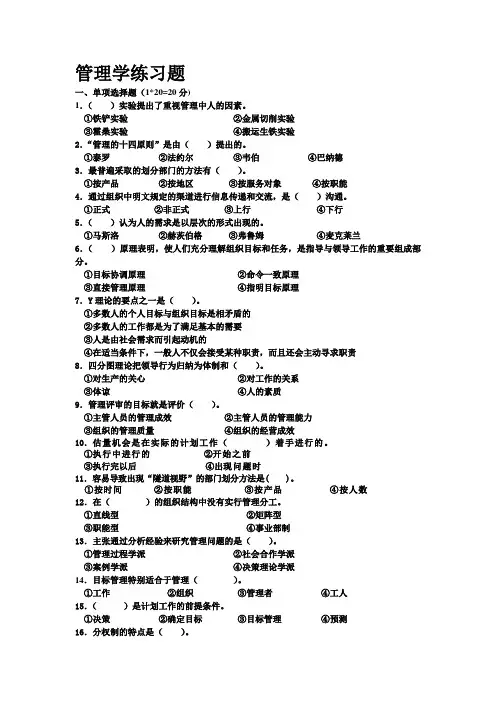
管理学练习题一、单项选择题(1*20=20分)1.()实验提出了重视管理中人的因素。
①铁铲实验②金属切削实验③霍桑实验④搬运生铁实验2.“管理的十四原则”是由()提出的。
①泰罗②法约尔③韦伯④巴纳德3.最普遍采取的划分部门的方法有()。
①按产品②按地区③按服务对象④按职能4.通过组织中明文规定的渠道进行信息传递和交流,是()沟通。
①正式②非正式③上行④下行5.()认为人的需求是以层次的形式出现的。
①马斯洛②赫茨伯格③弗鲁姆④麦克莱兰6.()原理表明,使人们充分理解组织目标和任务,是指导与领导工作的重要组成部分。
①目标协调原理②命令一致原理③直接管理原理④指明目标原理7.Y理论的要点之一是()。
①多数人的个人目标与组织目标是相矛盾的②多数人的工作都是为了满足基本的需要③人是由社会需求而引起动机的④在适当条件下,一般人不仅会接受某种职责,而且还会主动寻求职责8.四分图理论把领导行为归纳为体制和()。
①对生产的关心②对工作的关系③体谅④人的素质9.管理评审的目标就是评价()。
①主管人员的管理成效②主管人员的管理能力③组织的管理质量④组织的经营成效10.估量机会是在实际的计划工作()着手进行的。
①执行中进行的②开始之前③执行完以后④出现问题时11.容易导致出现“隧道视野”的部门划分方法是( )。
①按时间②按职能③按产品④按人数12.在()的组织结构中没有实行管理分工。
①直线型②矩阵型③职能型④事业部制13.主张通过分析经验来研究管理问题的是()。
①管理过程学派②社会合作学派③案例学派④决策理论学派14.目标管理特别适合于管理()。
①工作②组织③管理者④工人15.()是计划工作的前提条件。
①决策②确定目标③目标管理④预测16.分权制的特点是()。
①授予下属适当的决策权②权力全部下放③加强对下属的管理④加强民主管理17.人与人之间的共同过程中,()的因素有重要意义。
①生理②心理③社会④技术18.()不是组织工作的原理。
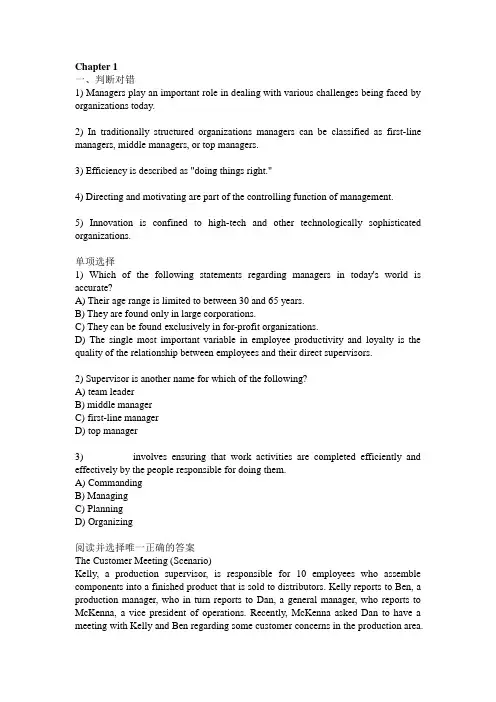
Chapter 1一、判断对错1) Managers play an important role in dealing with various challenges being faced by organizations today.2) In traditionally structured organizations managers can be classified as first-line managers, middle managers, or top managers.3) Efficiency is described as "doing things right."4) Directing and motivating are part of the controlling function of management.5) Innovation is confined to high-tech and other technologically sophisticated organizations.单项选择1) Which of the following statements regarding managers in today's world is accurate?A) Their age range is limited to between 30 and 65 years.B) They are found only in large corporations.C) They can be found exclusively in for-profit organizations.D) The single most important variable in employee productivity and loyalty is the quality of the relationship between employees and their direct supervisors.2) Supervisor is another name for which of the following?A) team leaderB) middle managerC) first-line managerD) top manager3) ________ involves ensuring that work activities are completed efficiently and effectively by the people responsible for doing them.A) CommandingB) ManagingC) PlanningD) Organizing阅读并选择唯一正确的答案The Customer Meeting (Scenario)Kelly, a production supervisor, is responsible for 10 employees who assemble components into a finished product that is sold to distributors. Kelly reports to Ben, a production manager, who in turn reports to Dan, a general manager, who reports to McKenna, a vice president of operations. Recently, McKenna asked Dan to have a meeting with Kelly and Ben regarding some customer concerns in the production area.The focus of the meeting was to judge the validity of the customer concerns, and to develop a specific plan to address these concerns.1) Kelly is a ________.A) top managerB) nonmanagerial employeeC) middle managerD) first-line managerAnswer: D2) Ben and Dan are ________.A) top managersB) middle managersC) supervisorsD) first-line managers3) McKenna is a ________.A) top managerB) supervisorC) middle managerD) first-line manager4) Kelly, Ben, Dan, and McKenna are part of an organization that has a ________.A) traditional committee structureB) traditional pyramid structureC) modern matrix structureD) modern jury structure问答题:1) Describe and provide examples of first-line, middle, and top managers.2) List and explain the four basic functions of management.Chapter 2判断题:1) In the symbolic view of management, managers are seen as directly responsible for an organization's success or failure.2) A dynamic environment is characterized by the absence of new competitors, few technological breakthroughs by current competitors, and little activity by pressure groups to influence the organization.3) Strong cultures have more influence on employees than do weak cultures.4) In order to develop an innovative organizational culture, managers must minimize ambiguity and uncertainty and discourage risk-taking.5) A valid criticism of workplace spirituality is that secular institutions, especially businesses, have no right to impose spiritual values on employees, if spirituality means bringing religion into the workplace.单项选择1) The current dominant assumption in management theory suggests that ________.A) an organization's success or failure is due to external forces outside managers' controlB) managers' roles are increasingly becoming peripheral and staff manage their own areas of expertiseC) managers are directly responsible for an organization's success or failureD) managers cannot significantly affect an organization's performance because they are constrained by the abilities of their employees2) The soccer league in England is notorious for the number of team managers fired over the course of a single season, which stands at no fewer than eight managers on average, owing to poor team form and consequently, poor results. It is evident from this information that the league endorses a(n) ________ view of management.A) symbolicB) omnipotentC) laissez-faireD) democratic3) According to the symbolic view, managers have a(n) ________ effect on substantive organizational outcomes.A) limitedB) extensiveC) influentialD) significant4) Which of the following are the two dimensions of environmental uncertainty?A) degree of change and degree of complexityB) degree of change and degree of volumeC) degree of complexity and degree of impactD) degree of impact and degree of timing5) ________ is a process that helps new employees learn the organization's way of doing things.A) ExternalizationB) SocializationC) DeculturationD) Transculturation6) Wendell interviews many middle-level managers and discovers that they share a different view of management. These individuals believe that external factors constrain managers' influence over outcomes. The mid-level managers have a(n) ________ view of management.A) traditionalB) omnipotentC) standardD) symbolic阅读并选择,单选Operating Within the Environment (Scenario)The environment places constraints on the behavior of managers. Suppose you are the manager of a real estate office trying to maximize profits. You attempt to understand the forces within your organization's environment.1) If the mortgage interest rates increase, this would be an example of changing ________ in your external environment.A) economic conditionsB) political conditionsC) sociocultural conditionsD) demographic conditions2) The area in which your office operates has been relatively stable in terms of land prices and demand. However, you have noticed that demand for housing in the area usually spikes in summer. Which of the following best describes your business environment?A) stable and simpleB) dynamic and simpleC) stable and complexD) dynamic and complex3) Imagine that the town to which your office caters sees a sudden spurt in popularity. There has been a lot of construction activity in the area and a number of properties are being developed. The number of customers has increased, and so have your competitors. In this situation, what should you do to reduce environmental uncertainty?A) Restrucutre your organizational hierarchy to improve efficiencyB) Acquire or merge with one or more of your competitorsC) Maintain the status quo by keeping your business processes constantD) Communicate the situation clearly to all your stakeholders问答题:1) Define environmental uncertainty. Briefly discuss the dimensions of environmental uncertainty.2) List the factors that influence the strength of an organization's culture and discuss the impact of a strong organizational culture on employees.Chapter 5判断题:1) According to the classical view of social responsibility, management's only social responsibility is to maximize profits.2) The term "values" refers to the principles and beliefs that define what is right and wrong behavior.单选选择1) Social obligation is the obligation of a business to meet its ________.A) social and technological responsibilitiesB) economic and social responsibilitiesC) technological and economic responsibilitiesD) economic and legal responsibilities2) The aspect that differentiates social responsibility from other similar concepts is that it adds a(n) ________.A) ethical imperativeB) legal imperativeC) political imperativeD) technical imperative3) According to the ________ argument on social responsibility, businesses should be socially responsible because responsible actions are the right thing to do.A) public expectationB) ethical obligationC) public imageD) long-run profit4) There are four approaches that organizations can take in order to go green. Which of the following is NOT a part of those approaches?A) legal approachB) market approachC) stakeholder approachD) operations approach5) One way to evaluate a company's green actions is to use the ________ list of the most sustainable corporations in the world.A) Global 100B) Global 90C) Global 80D) Global 70阅读并单选Two Opposing Views of Social Responsibility (Scenario)The board of directors of Acme Generating Corporation is meeting to consider the construction of a new electricity generation facility somewhere along the Muspetan River basin. The city of Muspetan has a high Air Pollution Index and the increasing amount of garbage is adding to the city's woes. Director Appleton would like the facility to be a coal-burning plant located in a remote area because the cost involved is moderate. Director Witworth wants a nuclear plant because this will not add to the city's already serious pollution problem, while taking care of its electricity requirements. Director Jossleman wants a plant that uses combustible fuels collected from the city's garbage. He wants the plant to be located near the downtown government area so that the steam could be used for heating the government buildings after it has passed through the generating turbines.1) Director Witworth is following which of the social responsibility views?A) market viewB) activist viewC) classical viewD) socioeconomic view2) Director Appleton is following which of the social responsibility views?A) legal viewB) stakeholder viewC) classical viewD) socioeconomic view3) Director Jossleman is being mostly ________.A) socially guardedB) socially focusedC) socially obligatedD) socially responsive问答题:1) Explain the four approaches that organizations can take with respect to environmental issues and going green.Chapter 6判断题1) The "calm waters" metaphor of change is consistent with Lewin's concept of unfreezing, changing, and refreezing.2) People may resist change based on habit.3) A leadership change can facilitate cultural change.单选:1) Labor strikes are an example of which of the following internal change factors?A) workforce compositionB) equipmentC) employee attitudesD) strategy2) Lewin's theory is consistent with the ________ theory of organizational change.A) white-water rapidsB) muckwaterC) mudwaterD) calm waters3) Organizational change is any alteration of ________.A) people, structure, or technologyB) structure, management, or goalsC) technology, goals, or managementD) rules, procedures, or management4) Which of the following is a physical symptom of stress?A) changes in metabolismB) changes in productivityC) job-related dissatisfactionD) job turnover5) Which of the following is a characteristic of a change-capable organization?A) separates the present and the futureB) makes controlling a way of lifeC) discourages mavericksD) shelters breakthroughs阅读并单选New Ideas (Scenario)Although New Ideas, Inc., has been in business for 30 years, the company and itsemployees seemingly have been in a constant state of change. Louis Snyder has been President of New Ideas, Inc. for the last 15 years. During these 15 years, he has had to change the strategic focus of the company three times. The employees have started becoming vocal about the decrease in their bonus checks and their desire for increased profits. It seems as though his competition is always introducing new products into the market and his company's niche products have to be constantly changed in order to keep up with the competition. Moreover, the government has been active in passing new legislation to increase the control of the product packaging and product contents. The technology used to manufacture the products has also been continually changed to make the process more efficient.1) The technology change in the manufacturing process of New Ideas, Inc.'s products to make the process more efficient is the result of a competitor lowering its price. Therefore, it was a(n) ________.A) external force of changeB) internal force of changeC) marketplace force of changeD) economic force of change2) Mr. Snyder has had to change the strategic focus of the company three times. The change in strategic focus of the New Ideas, Inc., is a(n) ________.A) external force of changeB) internal force of changeC) marketplace force of changeD) economic force of change3) When the employees express their concern about their bonus checks, which of the following types of forces of change is constraining Mr. Snyder?A) external force of changeB) labor market force of changeC) internal force of changeD) social force of change4) New Ideas, Inc., focuses on new ideas, uses technology that changes frequently, and has strong competition in the market. This situation describes what metaphor of change?A) a calm water metaphorB) a black-water rapid metaphorC) a rapid water metaphorD) a white-water rapids metaphor问答题:1) Define Organizational Development (OD). List and explain the five most popular OD techniques.2) What are the conditions that facilitate cultural change?Chapter 7判断:1) The decision-making process begins by identifying decision criteria.2) A decision criterion defines what is important or relevant to resolving a problem.3) A policy is an explicit statement that tells a manager what can or cannot be done.4) The sunk costs error occurs when decision makers forget that current choices cannot correct the past.单选:1) A(n) ________ is the existence of a discrepancy between an existing and a desired state of affairs.A) hazardB) riskC) uncertaintyD) problem2) To determine the ________, a manager must determine what is relevant or important to resolving a problem.A) bounded rationality of a decisionB) escalation of commitmentC) weight of the decision criteriaD) decision criteria3) Creativity is most essential in which of the following steps of the decision-making process?A) analyzing alternativesB) allocating weights to the decision criteriaC) developing alternativesD) identifying decision criteria4) The final step in the decision-making process is to ________.A) determine the criteria for the next decisionB) analyze the process of allocating weights to the decision criteriaC) evaluate the outcome of the decisionD) implement the chosen alternative5) When managers make decisions that are rational but limited by their ability to process the information, they are following the concept of ________.A) cognitive decision makingB) bounded rationalityC) escalation of commitmentD) intuitive decision making阅读并单选:Decision Making Biases and Errors (Scenario)Newcastle United, a soccer club, was relegated from the top flight two seasons ago. Following relegation, the club's board sacked the manager and hired a new manager to replace him. The club won back promotion to the league and enjoyed a good season. Andy Carroll, the star player for Newcastle, was the top scorer in the league for that season. However, the club, needing to strengthen the team by buying new players, sold Andy Carroll to Liverpool soccer club to buy three average players. The club is presently experiencing a dip in form and is in danger of being relegated again.1) Which of the following statements, if true, would indicate the presence of self-serving bias on the part of the manager?A) The manager assumes moral responsibility for the club's disappointing performance and offers to resign from his position.B) The manager buys Andy Carroll back from Liverpool at a much higher price to revive the team's fortunes.C) The manager blames the board for selling the top scorer and replacing him with below-par players.D) The manager threatens to quit if the board refuses to buy back Andy Carroll from Liverpool immediately.2) Which of the following statements, if true, best reflects sunk cost error on the part of the board?A) The board buys, a now out-of-form, Andy Carroll back from Liverpool at a much higher price in the hopes of reversing the team's form.B) The board admits that it underestimated Andy Carroll's real market value while selling him to Liverpool.C) The board blames the manager for buying three under-par players instead of one good replacement for Andy Carroll.D) The board backs the manager–who is confident that the team will be back in form–to improve the team's performance with its current players.问答题:1) Discuss the three types of programmed decisions that a manager depends on to resolve structured problems.Chapter 8判断:1) Planning is concerned with how objectives are to be accomplished, not what is to be accomplished.2) Absence of planning does not inhibit the ability of departments and individuals to work together or organizations to move.3) Most businesses have only the single goal of making profits.4) Directional plans are clearly defined and leave no room for interpretation.5) The commitment concept says that plans should extend far enough to meet those commitments made when the plans were developed.单选:1) Which of the following is one of the reasons why managers should plan?A) When work activities are coordinated around plans, inefficiencies become obvious.B) Uncertainty can be eliminated and the organization can be insulated from change with planning.C) Planning eliminates the need to set goals.D) Planning eliminates the need to measure work effort.2) The effect of planning on managers is that it forces them to ________.A) grow resistant to changeB) anticipate and respond to changeC) eliminate uncertaintyD) work at cross purposes3) Which aspect of planning refers to documents that outline how results are to be achieved?A) goalsB) plansC) objectivesD) performance4) Most company's goals can be classified as either ________ or ________.A) strategic; financialB) operational; tacticalC) social; economicD) strategic; operational5) ________ plans apply to the entire organization and establish the organization's overall goals.A) DepartmentalB) StrategicC) OperationalD) Specific阅读并单选Gator Corp. (Scenario)Gator Corp. has recently been accused of corporate espionage by a competitor, Alli Inc. Gator Corporation's CEO responded to this allegation by stating that the firm's actions were merely part of its competitor intelligence efforts. Alli Inc.'s CEO, however, believes otherwise.1) Which of the following statements, if true, would most strengthen Gator Corp.'s argument?A) One of the directors of Gator Corp. also serves on the board of Alli Inc.B) Several ex-employees of Gator Corp. have recently moved to Alli Inc.C) Gator Corp. has often used reverse engineering to understand its competitors' offerings.D) Alli Inc.'s sales have recently dipped, while Gator Corp. has witnessed a substantial increase in sales.2) Which of the following statements, if true, would most weaken Gator Corp.'s argument?A) Gator Corp. has been found guilty of violating intellectual property laws in the past.B) Gator Corp. has access to information belonging to Alli Inc., which is outside the public domain.C) Media reports suggest that Gator Corp. is in the process of developing a product comparable to Alli Inc.'s most popular offering.D) Alli Inc., has made similar allegations against other competitors in the past.问答题:1) White Forest Financials is a small investment firm, operating in an extremely volatile environment. One of the company's two owners, David White, is of the opinion that it would be futile for the company to engage in formal planning as the business environment is constantly shifting. However, the co-owner, Marsha Forest, believes that planning is essential for the company's success. Who would you support? Why?Page Ref: 205, 2132) In a short essay, list and discuss six characteristics of well-designed goals. Chapter 91) The first step in the strategic management process is analyzing the external environment.2) Exceptional or unique organizational resources are known as core capabilities.3) A stability strategy is an organizational strategy in which an organization maintains the status quo.单选:1) A ________ describes the rationale of how a company is going to make money.A) functional strategyB) business modelC) SWOT analysisD) core competency2) When an organization is analyzing its labor supply, it is studying its ________.A) organizational cultureB) internal environmentC) external environmentD) organizational mission3) ________ are positive trends in the external environment.A) StrengthsB) ThreatsC) WeaknessesD) Opportunities4) ________ takes place when a company combines with other companies in different, but associated, industries.A) Stabilized diversificationB) Horizontal integrationC) Vertical integrationD) Related diversification阅读并单选:SWOT Analysis (Scenario)As a process of self-examination during her senior year of college, Casey decides to develop a SWOT analysis of her prospects relative to getting a job.1) Casey realizes that she has a personal characteristic that suggests she is not comfortable interacting with strangers. She interprets this as a(n) ________ if she is to get a job as a salesperson.B) strengthC) weaknessD) opportunity2) Casey majored in marketing and really enjoyed studying market research as a subject. Through research on the Internet and in the university library, she discovers that this industry appears to have significant positive external trends. She interprets this as a(n) ________.A) weaknessB) threatC) strengthD) opportunity问答题:1) List and discuss the three levels of strategy that a large organization must develop.2) List and discuss the different types of corporate strategies.Chapter 10判断:1) Organizational structure is defined as the formal arrangement of jobs within an organization.2) Managers today continue to see work specialization as important because it helps employees be more efficient.3) A simple structure is characterized by low spans of controls and high formalization.单选:1) Organizational design is a process that involves decisions about ________.A) work specialization and cost-leadershipB) chain of command and span of controlC) centralization and differentiationD) departmentalization and diversification2) In case of functional departmentalization, jobs are grouped according to ________.A) tasksB) territoriesC) product linesD) customer flow问答:1) Define organizing and list its purpose.判断:1) Employee empowerment is crucial in organizations with team structures because no line of managerial authority flows from top to bottom in such organizations.2) The virtual organization is often called a modular organization by manufacturing firms.单选:1) Employee empowerment is a crucial aspect of which type of organizational design?A) bureaucratic structuresB) simple structuresC) functional structuresD) team structures2) All work in project structures is performed by ________.A) teamsB) functionsC) outside specialistsD) informal groups3) In order to succeed in today's world, organizations need to ________.A) be more flexible in how works get doneB) pace themselves when it comes to innovationC) strictly follow the top-down decision making approachD) adopt narrowly-defined functional arrangements阅读并单选CUB Industries (Scenario)CUB Industries has always followed a strict 9-to-5 work arrangement. However, due to the increasing diversity that they are witnessing in their workforce, they are considering exploring flexible work arrangements. These arrangements include flextime, telecommuting, and compressed work weeks among others.1) Which of the following, if true, would weaken the decision to offer employees the option of flextime?A) The company caters to a niche market with high-quality requirements for end-products.B) The company's workforce is quite young and several of the employees are pursuing their higher education on a part-time basis.C) The company's annual employee survey showed that most employees are capable of working independently without supervision.D) The work performed by the employees involves dealing with real-time information and live customer interaction.2) Which of the following, if true, would strengthen the organization's decision to support telecommuting?A) The organization's structure comprises of a network of virtual teams that need to be in constant contact with customers.B) The organization's workforce consists predominantly of young, unmarried employees.C) Research suggests that employee productivity increases when work arrangements facilitate greater personal interaction.D) The organization decided to switch to telecommuting as it's previous flextime work arrangement proved to be counter productive.3) Which of the following, if true, would support the organizations decision to offer employees a compressed work week arrangement?A) The organization plans to overcome its recent conflict with state labor laws that have risen due to increased employee fatigue and workplace mishaps.B) Compressed work week arrangements have consistently yielded greater profit margins for its competitors.C) The organization intends to promote greater work-life balance by providing employees with longer blocks of personal time and less commuting time.D) The company's annual employee survey suggested that most employees are highly motivated and productive while working independently.问答:1) List some of the benefits and drawbacks of collaborative work.Chapter 12判断:1) High-performance work practices are those that lead to both high individual and high organizational performance.2) Recruitment is defined as the process of screening job applicants to determine who is best qualified for the job.3) A new employee goes through two types of orientation: work unit orientation and procedural orientation.单选:1) Which of the following is an example of a high-performance work practice?A) closed communicationB) centralized decision makingC) skill-based compensationD) self-managed teams2) Which of the following laws prohibits discrimination on the basis of physical or mental disabilities?A) V ocational Rehabilitation ActB) Civil Rights Act, Title VIIC) Equal Pay ActD) Occupational Safety and Health Act3) Which of the following Acts requires continued health coverage following termination of an employee?A) Consolidated Omnibus Budget Reconciliation ActB) Occupational Safety and Health ActC) Health Insurance Portability and Accountability ActD) Family and Medical Leave Act4) The two most common forms of representative participation are ________.A) board representatives and cross-functional teamsB) task forces and labor unionsC) work councils and board representativesD) work councils and cross-functional teams阅读并单选:A Sign of the Times (Scenario)After considering the option for a long time, Jane's company has finally decided that it must "right-size," and this meant coming up with a plan for reducing the current size of the workforce at her manufacturing plant. The job was left to her, and as much as she hated doing this part of her job, it was necessary for the survival of the company and not just an effort to inflate their stock price. Jane also appreciated her company's attempt to try do what it takes to enhance profitability.1) In her next meeting with the senior management, Jane suggests that they should ignore the openings created by voluntary resignations and not hire any more people now. This would avoid much of the pain associated with workforce reduction in the future. This implies that Jane favors ________.A) transfersB) attritionC) layoffsD) reduced workweeks2) Jane checks with the different departments and tries to get an idea of employee productivity at different levels. In consultation with the various managers, she makes a list of the relatively less productive employees who have not been up to the mark despite training and mentoring. They decide to terminate their employment contracts for the time being. She meets with each and every one of them to clarify the position。
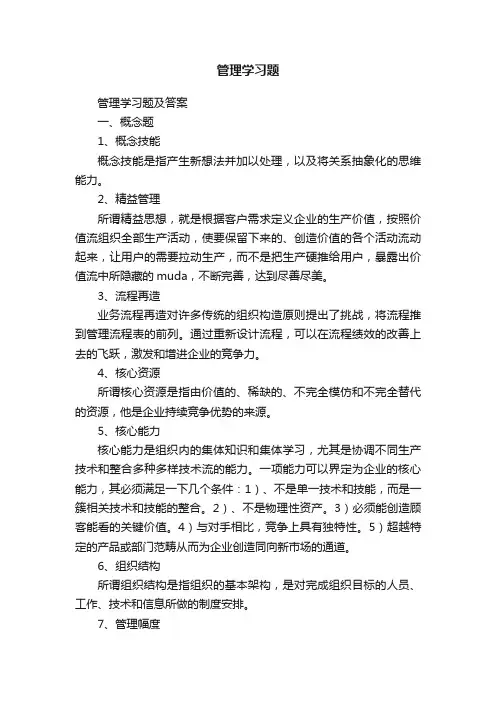
管理学习题管理学习题及答案一、概念题1、概念技能概念技能是指产生新想法并加以处理,以及将关系抽象化的思维能力。
2、精益管理所谓精益思想,就是根据客户需求定义企业的生产价值,按照价值流组织全部生产活动,使要保留下来的、创造价值的各个活动流动起来,让用户的需要拉动生产,而不是把生产硬推给用户,暴露出价值流中所隐藏的muda,不断完善,达到尽善尽美。
3、流程再造业务流程再造对许多传统的组织构造原则提出了挑战,将流程推到管理流程表的前列。
通过重新设计流程,可以在流程绩效的改善上去的飞跃,激发和增进企业的竞争力。
4、核心资源所谓核心资源是指由价值的、稀缺的、不完全模仿和不完全替代的资源,他是企业持续竞争优势的来源。
5、核心能力核心能力是组织内的集体知识和集体学习,尤其是协调不同生产技术和整合多种多样技术流的能力。
一项能力可以界定为企业的核心能力,其必须满足一下几个条件:1)、不是单一技术和技能,而是一簇相关技术和技能的整合。
2)、不是物理性资产。
3)必须能创造顾客能看的关键价值。
4)与对手相比,竞争上具有独特性。
5)超越特定的产品或部门范畴从而为企业创造同向新市场的通道。
6、组织结构所谓组织结构是指组织的基本架构,是对完成组织目标的人员、工作、技术和信息所做的制度安排。
7、管理幅度管理幅度也成组织幅度,是指组织中上级主管能够有效的指挥和领导下属的数量。
8、管理层次由于组织任务存在递减性,从最高层的主管和最底的基层具体工作人员之间就形成了一定的层次,这种层次就成为组织层次。
9、集权集权是指决策指挥权在组织层次系统中较高层次上的集中,也就是说下级机构和部门只能依据上级的决定、命令和知识办事,一切行动必须服从上级指挥。
10、分权指决策指挥权在组织层次系统中较低管理层次上的分散。
11、授权组织内部为了共享内部权力,激励员工努力工作,而把某些权力或职权授予下级。
12、组织变革组织根据内外环境变化,及时明确组织活动的内容或重点,并据此对组织中的岗位、机构(岗位的组合)以及结构(机构间的权力配置)进行调整,以适应组织发展的要求。
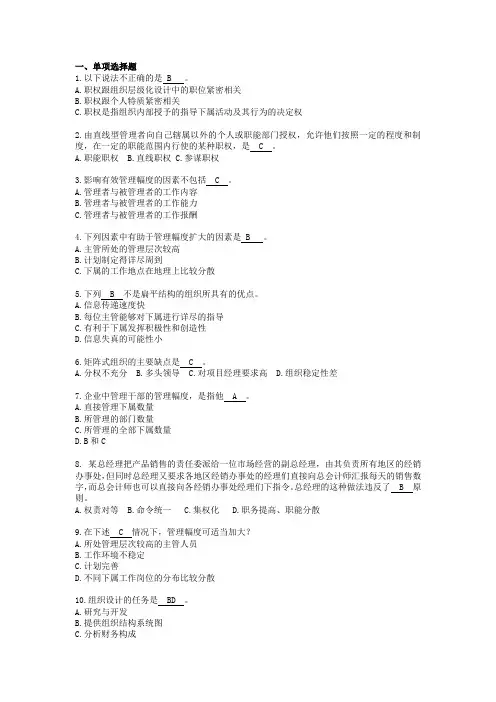
一、单项选择题1.以下说法不正确的是 B 。
A.职权跟组织层级化设计中的职位紧密相关B.职权跟个人特质紧密相关C.职权是指组织内部授予的指导下属活动及其行为的决定权2.由直线型管理者向自己辖属以外的个人或职能部门授权,允许他们按照一定的程度和制度,在一定的职能范围内行使的某种职权,是 C 。
A.职能职权B.直线职权C.参谋职权3.影响有效管理幅度的因素不包括 C 。
A.管理者与被管理者的工作内容B.管理者与被管理者的工作能力C.管理者与被管理者的工作报酬4.下列因素中有助于管理幅度扩大的因素是 B 。
A.主管所处的管理层次较高B.计划制定得详尽周到C.下属的工作地点在地理上比较分散5.下列 B 不是扁平结构的组织所具有的优点。
A.信息传递速度快B.每位主管能够对下属进行详尽的指导C.有利于下属发挥积极性和创造性D.信息失真的可能性小6.矩阵式组织的主要缺点是 C 。
A.分权不充分B.多头领导C.对项目经理要求高D.组织稳定性差7.企业中管理干部的管理幅度,是指他 A 。
A.直接管理下属数量B.所管理的部门数量C.所管理的全部下属数量D.B和C8. 某总经理把产品销售的责任委派给一位市场经营的副总经理,由其负责所有地区的经销办事处,但同时总经理又要求各地区经销办事处的经理们直接向总会计师汇报每天的销售数字,而总会计师也可以直接向各经销办事处经理们下指令。
总经理的这种做法违反了 B 原则。
A.权责对等B.命令统一C.集权化D.职务提高、职能分散9.在下述 C 情况下,管理幅度可适当加大?A.所处管理层次较高的主管人员B.工作环境不稳定C.计划完善D.不同下属工作岗位的分布比较分散10.组织设计的任务是 BD 。
A.研究与开发B.提供组织结构系统图C.分析财务构成D.编制职务说明书11.在各组织中,管理层次要受到 C 的影响。
A.组织成员B.组织规模C.管理幅度D.组织层次12.管理层次与管理幅度的反比关系决定了两种基本的 CD 管理组织结构形态。
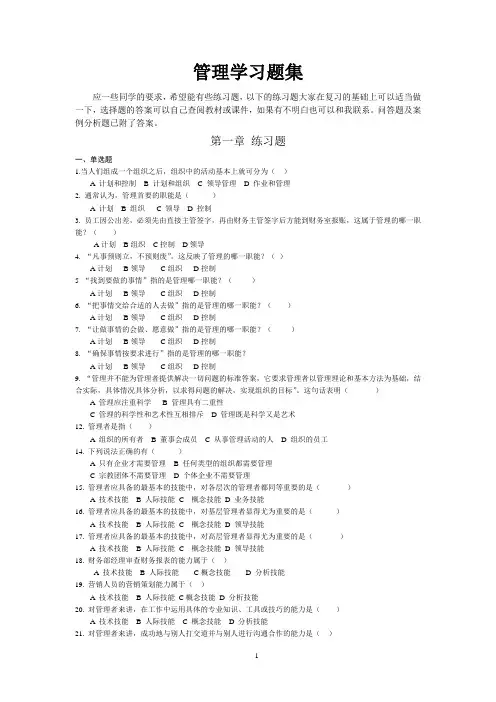
管理学习题集应一些同学的要求,希望能有些练习题,以下的练习题大家在复习的基础上可以适当做一下,选择题的答案可以自己查阅教材或课件,如果有不明白也可以和我联系。
问答题及案例分析题已附了答案。
第一章练习题一、单选题1.当人们组成一个组织之后,组织中的活动基本上就可分为()A 计划和控制B 计划和组织C 领导管理D 作业和管理2. 通常认为,管理首要的职能是()A 计划B 组织C 领导D 控制3. 员工因公出差,必须先由直接主管签字,再由财务主管签字后方能到财务室报账,这属于管理的哪一职能?()A计划B组织C控制D领导4. “凡事预则立,不预则废”。
这反映了管理的哪一职能?()A计划B领导C组织D控制5 “找到要做的事情”指的是管理哪一职能?()A计划B领导C组织D控制6. “把事情交给合适的人去做”指的是管理的哪一职能?()A计划B领导C组织D控制7. “让做事情的会做、愿意做”指的是管理的哪一职能?()A计划B领导C组织D控制8. “确保事情按要求进行”指的是管理的哪一职能?A计划B领导C组织D控制9. “管理并不能为管理者提供解决一切问题的标准答案,它要求管理者以管理理论和基本方法为基础,结合实际,具体情况具体分析,以求得问题的解决,实现组织的目标”。
这句话表明()A 管理应注重科学B 管理具有二重性C 管理的科学性和艺术性互相排斥D 管理既是科学又是艺术12. 管理者是指()A 组织的所有者B 董事会成员C 从事管理活动的人D 组织的员工14. 下列说法正确的有()A 只有企业才需要管理B 任何类型的组织都需要管理C 宗教团体不需要管理D 个体企业不需要管理15. 管理者应具备的最基本的技能中,对各层次的管理者都同等重要的是()A 技术技能B 人际技能C 概念技能D 业务技能16. 管理者应具备的最基本的技能中,对基层管理者显得尤为重要的是()A 技术技能B 人际技能C 概念技能D 领导技能17. 管理者应具备的最基本的技能中,对高层管理者显得尤为重要的是()A 技术技能B 人际技能C 概念技能D 领导技能18. 财务部经理审查财务报表的能力属于()A 技术技能B 人际技能C概念技能 D 分析技能19. 营销人员的营销策划能力属于()A 技术技能B 人际技能C概念技能D 分析技能20. 对管理者来讲,在工作中运用具体的专业知识、工具或技巧的能力是()A 技术技能B 人际技能C 概念技能D 分析技能21. 对管理者来讲,成功地与别人打交道并与别人进行沟通合作的能力是()A 技术技能B 人际技能C 概念技能D 分析技能22. 对管理者来讲,对事物进行全局分析、判断、洞察、概括的能力是()A 技术技能B 人际技能C 概念技能D 决策技能23. 美国管理学家彼得·德鲁克说过,如果你理解管理理论,但不具备管理技术和管理工具的运用能力,那么你还不是一个有效的管理者;反过来,如果你具备这个能力,而不掌握管理理论,那么充其量你只是一个技术员。
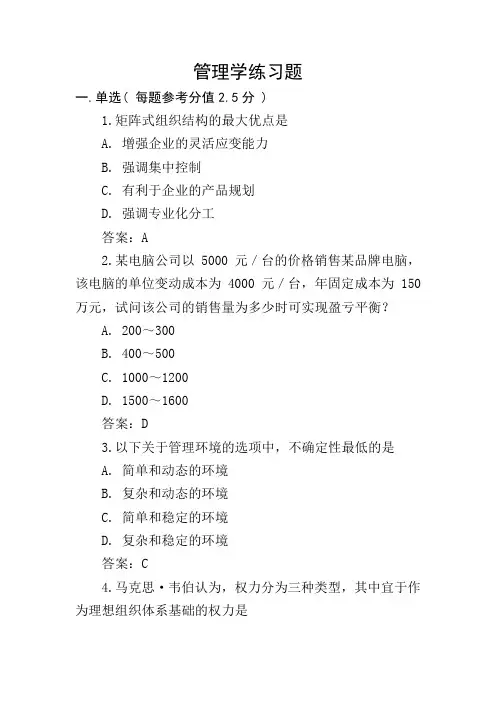
管理学练习题一.单选( 每题参考分值2.5分 )1.矩阵式组织结构的最大优点是A. 增强企业的灵活应变能力B. 强调集中控制C. 有利于企业的产品规划D. 强调专业化分工答案:A2.某电脑公司以5000元/台的价格销售某品牌电脑,该电脑的单位变动成本为4000元/台,年固定成本为150万元,试问该公司的销售量为多少时可实现盈亏平衡?A. 200~300B. 400~500C. 1000~1200D. 1500~1600答案:D3.以下关于管理环境的选项中,不确定性最低的是A. 简单和动态的环境B. 复杂和动态的环境C. 简单和稳定的环境D. 复杂和稳定的环境答案:C4.马克思·韦伯认为,权力分为三种类型,其中宜于作为理想组织体系基础的权力是A. 传统的权力B. 超凡的权力C. 理性一合法的权力D. 职位权力答案:C5.确定合理的管理幅度是组织设计的一项重要内容。
对于下列说法,你最赞同哪一个?A. 管理幅度越窄,越易控制,管理人员的费用也越低。
B. 管理幅度越宽,组织层次越少,但管理人员的费用会上升。
C. 管理幅度应视管理者能力.下属素质.工作性质等因素而定。
D. 管理幅度的确定对组织而言并不重要,无须过多考虑。
答案:C6.被后人称为“组织理论之父”的是A. 泰勒B. 梅奥C. 韦伯D. 西蒙答案:C7.按控制的时间划分,控制工作分为A. 现场控制.持续控制.前馈控制B. 现场控制.反馈控制.结果控制C. 现场控制.反馈控制.前馈控制D. 结果控制.反馈控制.前馈控制答案:C8.决策理论派的代表人物是A. 韦伯B. 孔茨C. 巴纳德D. 西蒙答案:D9.组织规模一定情况下,管理幅度与管理层次呈A. 正比关系B. 指数关系C. 反比关系D. 相关关系答案:C10.如果发现一个组织中小道消息很多,而正式渠道的消息较少。
据此,你认为该组织存在什么问题?A. 正式沟通渠道中信息传递很通畅,运作良好。
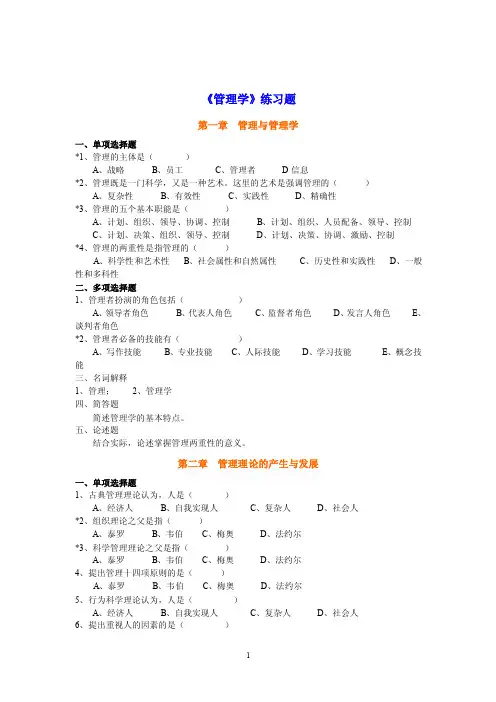
《管理学》练习题第一章管理与管理学一、单项选择题*1、管理的主体是()A、战略B、员工C、管理者D信息*2、管理既是一门科学,又是一种艺术。
这里的艺术是强调管理的()A、复杂性B、有效性C、实践性D、精确性*3、管理的五个基本职能是()A、计划、组织、领导、协调、控制B、计划、组织、人员配备、领导、控制C、计划、决策、组织、领导、控制D、计划、决策、协调、激励、控制*4、管理的两重性是指管理的()A、科学性和艺术性B、社会属性和自然属性C、历史性和实践性D、一般性和多科性二、多项选择题1、管理者扮演的角色包括()A、领导者角色B、代表人角色C、监督者角色D、发言人角色E、谈判者角色*2、管理者必备的技能有()A、写作技能B、专业技能C、人际技能D、学习技能E、概念技能三、名词解释1、管理;2、管理学四、简答题简述管理学的基本特点。
五、论述题结合实际,论述掌握管理两重性的意义。
第二章管理理论的产生与发展一、单项选择题1、古典管理理论认为,人是()A、经济人B、自我实现人C、复杂人D、社会人*2、组织理论之父是指()A、泰罗B、韦伯C、梅奥D、法约尔*3、科学管理理论之父是指()A、泰罗B、韦伯C、梅奥D、法约尔4、提出管理十四项原则的是()A、泰罗B、韦伯C、梅奥D、法约尔5、行为科学理论认为,人是()A、经济人B、自我实现人C、复杂人D、社会人6、提出重视人的因素的是()A、条件反向试验B、霍桑试验C、铁锹试验D、工厂照明试验7、主张通过分析经验来研究管理学问题的学派是()A、管理过程学派B、社会合作系统学派C、案例学派D、决策理论学派*8、认为没有“放之四海而皆准”的普遍适用的“最好的”管理学派是()A、权变理论学派B、社会合作学派C、管理科学学派遣D、管理过程学派二、名词解释1、例外原则;2、“跳板”原则;3、霍桑试验三、简答题1、简述梅奥人群关系理论的主要内容。
2、简单分析权变理论学派的观点。
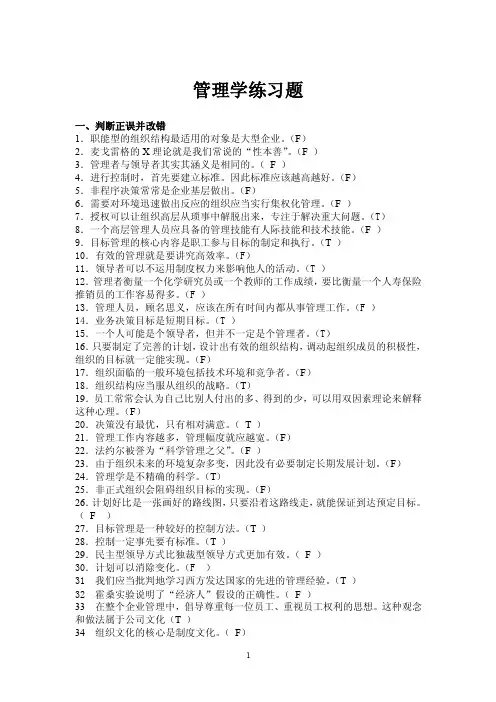
管理学练习题一、判断正误并改错1.职能型的组织结构最适用的对象是大型企业。
(F)2.麦戈雷格的X理论就是我们常说的“性本善”。
(F )3.管理者与领导者其实其涵义是相同的。
(F )4.进行控制时,首先要建立标准。
因此标准应该越高越好。
(F)5.非程序决策常常是企业基层做出。
(F)6.需要对环境迅速做出反应的组织应当实行集权化管理。
(F )7.授权可以让组织高层从琐事中解脱出来,专注于解决重大问题。
(T)8.一个高层管理人员应具备的管理技能有人际技能和技术技能。
(F )9.目标管理的核心内容是职工参与目标的制定和执行。
(T )10.有效的管理就是要讲究高效率。
(F)11.领导者可以不运用制度权力来影响他人的活动。
(T )12.管理者衡量一个化学研究员或一个教师的工作成绩,要比衡量一个人寿保险推销员的工作容易得多。
(F )13.管理人员,顾名思义,应该在所有时间内都从事管理工作。
(F )14.业务决策目标是短期目标。
(T )15.一个人可能是个领导者,但并不一定是个管理者。
(T)16.只要制定了完善的计划,设计出有效的组织结构,调动起组织成员的积极性,组织的目标就一定能实现。
(F)17.组织面临的一般环境包括技术环境和竞争者。
(F)18.组织结构应当服从组织的战略。
(T)19.员工常常会认为自己比别人付出的多、得到的少,可以用双因素理论来解释这种心理。
(F)20.决策没有最优,只有相对满意。
(T )21.管理工作内容越多,管理幅度就应越宽。
(F)22.法约尔被誉为“科学管理之父”。
(F )23.由于组织未来的环境复杂多变,因此没有必要制定长期发展计划。
(F)24.管理学是不精确的科学。
(T)25.非正式组织会阻碍组织目标的实现。
(F)26.计划好比是一张画好的路线图,只要沿着这路线走,就能保证到达预定目标。
(F )27.目标管理是一种较好的控制方法。
(T )28.控制一定事先要有标准。
(T )29.民主型领导方式比独裁型领导方式更加有效。
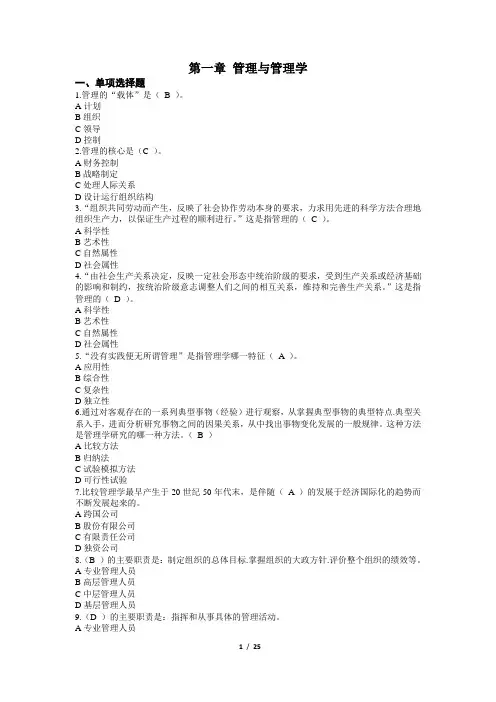
第一章管理与管理学一、单项选择题1.管理的“载体”是(B )。
A计划B组织C领导D控制2.管理的核心是(C )。
A财务控制B战略制定C处理人际关系D设计运行组织结构3.“组织共同劳动而产生,反映了社会协作劳动本身的要求,力求用先进的科学方法合理地组织生产力,以保证生产过程的顺利进行。
”这是指管理的(C )。
A科学性B艺术性C自然属性D社会属性4.“由社会生产关系决定,反映一定社会形态中统治阶级的要求,受到生产关系或经济基础的影响和制约,按统治阶级意志调整人们之间的相互关系,维持和完善生产关系。
”这是指管理的(D )。
A科学性B艺术性C自然属性D社会属性5.“没有实践便无所谓管理”是指管理学哪一特征(A )。
A应用性B综合性C复杂性D独立性6.通过对客观存在的一系列典型事物(经验)进行观察,从掌握典型事物的典型特点.典型关系入手,进而分析研究事物之间的因果关系,从中找出事物变化发展的一般规律。
这种方法是管理学研究的哪一种方法。
(B )A比较方法B归纳法C试验模拟方法D可行性试验7.比较管理学最早产生于20世纪50年代末,是伴随(A )的发展于经济国际化的趋势而不断发展起来的。
A跨国公司B股份有限公司C有限责任公司D独资公司8.(B )的主要职责是:制定组织的总体目标.掌握组织的大政方针.评价整个组织的绩效等。
A专业管理人员B高层管理人员C中层管理人员D基层管理人员9.(D )的主要职责是:指挥和从事具体的管理活动。
A专业管理人员B高层管理人员C中层管理人员D基层管理人员10.(B )对于任何层次的管理人员来说,都是同等重要的。
A技术技能B人事技能C决策技能D概念技能11.按照人本原理的观点,现代管理的核心是(B )。
A人是管理的主体B有效管理的关键是员工参与C使人性得到最完美的发展D管理是为人服务的12.在人本原理的动力原则中,(A )是根本。
A物质动力B精神动力C信息动力D外界压力13.在现代管理中,(A )是管理的主体。
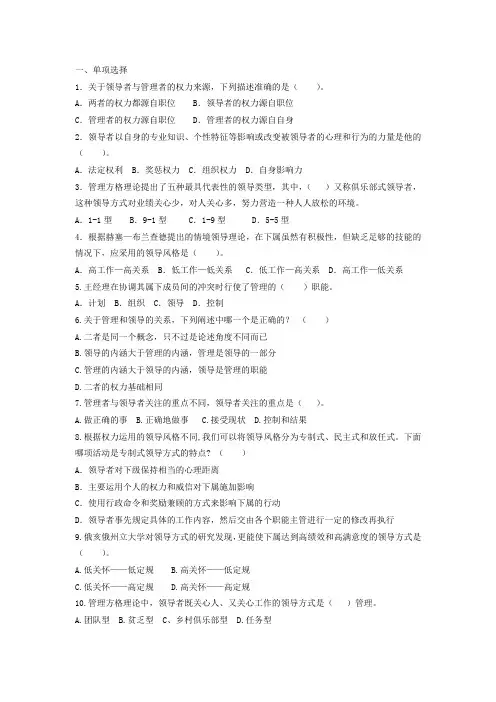
一、单项选择1.关于领导者与管理者的权力来源,下列描述准确的是()。
A.两者的权力都源自职位 B.领导者的权力源自职位C.管理者的权力源自职位 D.管理者的权力源自自身2.领导者以自身的专业知识、个性特征等影响或改变被领导者的心理和行为的力量是他的()。
A.法定权利 B.奖惩权力 C.组织权力 D.自身影响力3.管理方格理论提出了五种最具代表性的领导类型,其中,()又称俱乐部式领导者,这种领导方式对业绩关心少,对人关心多,努力营造一种人人放松的环境。
A.1-1型 B.9-1型 C.1-9型 D.5-5型4.根据赫塞—布兰查德提出的情境领导理论,在下属虽然有积极性,但缺乏足够的技能的情况下,应采用的领导风格是()。
A.高工作—高关系 B.低工作—低关系 C.低工作—高关系 D.高工作—低关系5.王经理在协调其属下成员间的冲突时行使了管理的()职能。
A.计划 B.组织 C.领导 D.控制6.关于管理和领导的关系,下列阐述中哪一个是正确的?()A.二者是同一个概念,只不过是论述角度不同而已B.领导的内涵大于管理的内涵,管理是领导的一部分C.管理的内涵大于领导的内涵,领导是管理的职能D.二者的权力基础相同7.管理者与领导者关注的重点不同,领导者关注的重点是()。
A.做正确的事B.正确地做事C.接受现状D.控制和结果8.根据权力运用的领导风格不同,我们可以将领导风格分为专制式、民主式和放任式。
下面哪项活动是专制式领导方式的特点? ()A.领导者对下级保持相当的心理距离B.主要运用个人的权力和威信对下属施加影响C.使用行政命令和奖励兼顾的方式来影响下属的行动D.领导者事先规定具体的工作内容,然后交由各个职能主管进行一定的修改再执行9.俄亥俄州立大学对领导方式的研究发现,更能使下属达到高绩效和高满意度的领导方式是()。
A.低关怀——低定规B.高关怀——低定规C.低关怀——高定规D.高关怀——高定规10.管理方格理论中,领导者既关心人、又关心工作的领导方式是()管理。
第七章创新职能习题一、单项选择题1.下面哪项不属于管理的“维持职能”()。
A.组织 B .领导 C .控制 D .创新2.从创新与环境的关系来分析,可将创新分为()。
A.自发创新与有组织的创新 B .消极防御型创新与积极攻击型创新C.局部创新与整体创新 D .系统初建期的创新与运行中的创新3.最先给出创新的定义的人是()。
A.约瑟夫·熊彼特 B.罗纳德·科斯C.哈罗德·孔茨 D.彼得·德鲁克4、下列选项中,不属于创新活动的是()。
A.设备的更新改造 B .产品的开发C.质量的检验 D .工艺的改进5.制度创新需要从()角度来分析企业系统中各成员间的正式关系的调整和变革。
A.社会经济 B.技术 C.社会变化 D.组织结构6.不断寻找机会,通过创新满足需要,赋予资源以生产财富能力的人称为()。
A.开创者 B .企业家 C.企业家精神 D.领导者7.经营制度的创新方向是()。
A.寻求生产资料的社会成员“个人所有”与“共同共有”的最适度组合B.不断地追求和实现报酬与贡献的更高层次上的平衡C.不断调整和优化企业所有者、经营者、劳动者三者之间的关系,使各个方面的权力和利益得到充分的体现D.不断寻求企业生产资料最有效利用的方式8 .在特定时期内对某一社会经济系统(组织)的管理工作主要包括下述内容:(1)在系统运行过程中,协调各部分的关系,使他们的工作相互衔接、平衡地运行(2)制定并选择可实现目标的行动方案(3)注视内外条件的变化,寻找并利用变革的机会,计划并组织实施系统的变革和发展(4)分解目标活动,据此设计系统所需要的职务、岗位,并加以组合,规定它们之间相互关系,形成一定的系统结构(5)检查和控制各部门的工作,纠正实际工作中的失误和偏差,使之符合预定的要求(6)根据各岗位的工作要求,招聘和调配工作人员(7)确立系统的目标,即人们从事某项活动希望达到的状况和水平(8)发布工作指令,组织供应各环节活动所需的物质和信息条件,使系统运行起来上述活动正确的逻辑顺序是()。
第一章一、填空题1、法国工业家法约尔在其《工业管理与一般管理》中把管理的职能分为计划、组织、指挥、协调和控制。
2、管理的载体是组织,本质是合理分配和协调的过程,目的是实现既定目标。
3、明茨伯格发现管理者扮演者十种角色,这十种角色可以被归入三类:人际角色、信息角色和决策角色。
4、科学管理理论着重研究如何提高单个工人的生产率。
5、梅奥认为提高生产率的主要途径是提高工人的满足度。
二、单项选择题1、下列哪位学者提出“管理就是决策”的主张?()A 亚当·斯密B 泰罗C 罗伯特·欧文D 西蒙2、梅奥的管理思想中对人性的认识是。
( C )A 受雇佣人B 经济人C 社会人D 复杂人3、下列哪项职能是管理职能的灵魂和生命。
( A )A 创新B 决策C 领导D 控制4、泰罗的科学管理理论出现在( ) 。
A 19世纪末20世纪初B 20世纪30年代C 20世纪40年代D 20世纪60年代5、把二战后管理理论研究的多姿多彩局面概括为“管理理论丛林”的是()。
A 福特B 孔茨C 马斯洛D 巴纳德三、判断题1、学习型组织就是要抽取一定时间来学习专业知识的一种组织。
()2、虚拟组织有固定的组织层次和内部命令系统,是一种开放的组织结构。
()3、组织中向外界发布信息的管理角色称为组织发言人。
()4、计划工作之后自然就会需要组织工作来发挥作用。
()5、相对于基层和中层管理者而言,高层管理者最重要的技能是人际技能。
()。
四、简答题1、简述泰罗的贡献?答:泰罗的科学管理理论(1)工作定额(2)标准化(3)能力与工作相适应(4)差别计件工资制(5)计划职能与执行职能相分离2、简述梅奥霍桑试验的内容?答:第二章一、填空题1、伦理最初的自然形态是风俗习惯。
2、伦理道德是现代社会的核心价值构件,具有特殊的管理意义和文明意义,而道德就是在一定风俗习惯下所形成的个人品质、气质。
3、根据巴纳德的组织理论,组织的形成有三个要素:共同目的、协作的愿望和信息的沟通。
管理学练习题及答案(周三多)第一章管理与管理学一、名词解释1、管理2、管理职能3、霍桑试验4、权变管理理论二、单项选择1、下列哪位管理学者提出“管理就是决策”的主张()A、赫伯特·A西蒙B、彼得·F·德鲁克C、弗雷德·E·费德勒D、弗里蒙特·E·卡斯特2、管理的核心是()A、处理组织内部资源的稀缺问题B、处理与组织外部的关系C、处理各种人际关系D、处理组织内部与组织外部的一致性关系3、管理具有与生产关系、与社会制度相联系的一面,这里是指()A、管理的自然属性B、管理的社会属性C、管理的科学性D、管理的艺术性4、管理者必须因地制宜地将管理知识与具体管理活动相结合,这里强调的是()A、管理的科学性B、管理的艺术性C、管理学的历史性D、管理学的实用性5、“X—Y”理论的代表人物是()A、麦格雷戈B、赫兹伯格C、梅奥D、马斯洛6、社会合作系统学派的代表人物是()A、法约尔B、西蒙C、巴纳德D、卢桑斯7、系统与权变理论把人看作是()A、经济人B、社会人C、自我实现人D、复杂人8、决策理论学派的代表人物是()A.巴纳德 B.西蒙 C.卡斯特 D.卢桑斯三、多项选择1、管理的二重性是指()A、管理的自然属性B、管理的社会属性C、管理的科学性D、管理的艺术性2、下列关于管理过程的描述,正确的有()A、管理过程和管理职能是统一的B、管理过程和管理职能是分离的C、管理过程是动态中的管理D、管理过程中静态中的管理E、管理过程也是信息变换的过程3、从科学的定义上讲,存在管理必须具备以下条件:()A、必须是两个人以上的集体活动B、必须是具有盈利动机的集体活动C、必须是正式组织D、必须是非正式组织E、必须具有一致认可的、自觉的目标4、赫兹伯格理论中的“双因素”是指()A.保健 B.激励 C.X理论 D.Y理论四、是非判断1、管理就是由一个或若干个人通过行使各种管理职能,使组织中以人为主体的各种要素的合理配置,从而达到实现组织目标而进行的活动。
一、单项选择题1、领导的实质是指( C )A、决策 B、指挥C、对被领导者施加影响力D、管制、监督下属认2、领导者有权对组织内部的一些违纪行为给予一定的处分或惩罚,指的是( B )A、法定权B、强制权C、奖赏权D、处分权3、在布莱克的方格理论中,属于战斗集体型的管理是(C)A、(1,9)型B、(9,1)型C、(9,9)型D、(5,5)型4、根据布莱克的方格理论,最为有效的管理应是( C )A、(1,9)型 B、(9,1)型 C、(9,9)型D、(5,5)型5、在领导理论研究中,最先提出领导周期理论的是( D )A、赫塞B、布兰查德 C、费德勒D、科曼6、对于较不成熟的下属,较为有效的领导风格是( B )A、指导型B、推销型C、参与型D、授权型7、对于高度成熟的下属,较为有效的领导风格是(C)A、指导型B、推销型C、参与型 D、授权型8.将领导者分为事务型领导者和战略型领导者是以 C 为标准来分的。
A.领导者权力运用方式B.领导者在领导过程中进行制度创新的方式C.领导者在领导过程中的思维方式9.俄亥俄州立大学队领导方式的研究发现, B 的领导者一般更能使下属达到高绩效和高满意度。
A.高关怀-高定规B.高关怀-低定规C.低关怀-高定规D.低关怀-低定规10.下列理论 B 不属于领导情景论。
A.权变理论B. 路径-目标理论C.领导生命周期理论 D.管理方格论11. A 认为各种领导方式都有可能在一定环境内有效,这种环境是多种外部与内部因素的综合作用体。
A.权变理论B.路径-目标理论C.领导生命周期理论D.管理方格论12. 管理方格论中,表示领导者只重视任务效果而不重视下属发展和士气的是 E 。
A.乡村俱乐部B.贫乏型 C.中庸之道D.团队型 E.任务型13.乡村俱乐部型领导方式位于管理方格图的 B 格。
A.9.1B.1.9 C.5.5 D.9.9 E.1.114.根据权变理论,在环境较差的情况下,采用 B 的方式比较有效。
管理学练习题一、单项选择题(从每题的四个备选答案中,选出一个正确的答案,并将正确答案的字母标号填入括号内.每题1分,共40分)1、19世纪末20世纪初的()的出现,是管理学形成的标志。
A、泰勒科学管理B、法约尔一般管理C、韦伯组织理论D、梅奥人际关系学说2、法约尔被誉为()之父A、经营管理B、科学管理C、组织管理D、人事管理3、决策理论学派的代表人物是()A、赫兹伯格B、马斯洛C、西蒙D、卡斯特4、管理的首要职能是()A、组织B、领导C、计划D、控制5、实行目标管理,对于目标的制定工作,下级()A、要参与B、要回避C、不要参加D、不要传达6、提出公平理论的管理学家是()A、赫兹伯格B、斯金纳C、亚当斯D、弗鲁姆7、组织是()A、开放的系统B、封闭的系统C、相对独立的开放系统D、相对独立的封闭系统8、《社会和经济组织的理论》是( )的著作.A、法国人法约尔B、德国人韦伯C、美国人巴纳德D、英国人亚当.斯密9、管理工作的本质特点主要表现为,管理工作具有()双重特征。
A、自然属性和社会属性B、定量和定性C、程序和非程序D、科学性和艺术性10、()由彼得。
德鲁克在50年代提出,经由其他一些人发展,逐步成为西方许多国家所普遍采用的一种系统地制定目标并进行管理的有效方法。
A、目标管理B、滚动计划法C、SWOT分析法D、计划评审技术11、()需要更多地掌握概念性技能。
A、中层管理人员B、高层管理人员C、基层管理人员D、作业人员12、计划工作的核心是()。
A、决策B、预测C、构思D、控制13、法约尔提出的组织中平级的横向沟通被称为().A、等级原则B、协商原则C、跳板原则D、秩序原则14、()是法约尔的代表作。
A、工业管理与一般管理B、科学管理原理C、社会和经济组织理论D、工业文明的人类问题15、()是从悲观否定的观点来看待工人的。
A、Y理论B、超Y理论C、X理论D、“社会人”观点16、一个组织内部的规章制度属于()的。
第十三章控制(练习与思考)一、单项选择题1.“治病不如防病,防病不如讲卫生”。
根据这一说法,以下几种控制方式中,哪一种最重要?( )。
A. 直接控制B. 反馈控制C. 前馈控制D. 同期控制2. 具有监督和指导两方面作用的是( )。
A. 前馈控制B. 反馈控制C. 同期控制D. 直接控制3. 一个有效的控制系统其控制主体应该是( )。
A. 各级管理者B. 全体员工C. 监督机构D. 上级机关4. 一个工人每天或每周必须完成生产一定数目的零件,他必须保持不超过1%的废品率,他必须在指定的6个月内完成预定的工作,在生产特定数目的零件时不能超过所规定的物料消耗。
对于控制来讲,这是在( )。
A. 衡量实际绩效B. 进行差异分析C. 采取纠偏措施D. 明确控制标准5. 某企业制定劳动定额时,出现了以下四种意见,你认为哪一种意见比较正确?( )A. 劳动定额主要是为了考核用的,所以应该选择最先进的标准B. 定额标准的确定应该结合企业实际,并考虑有助于员工积极性的调动C. 为使绝大多数员工能超额完成任务,应该选择最低的定额标准D. 考虑到员工操作水平的差异性,定额标准宜取最先进与最低标准的平均值6. 小李是一家合资企业的总经理助理,为了提高企业的经济效益,总经理要求他研究提出一套加强企业的管理控制、建立企业有效管理控制系统的可行方案。
总经理在提出工作要求时提醒他一定要做到“牵牛要牵牛鼻子”。
小李分析了半天也不知道应该如何去牵“牛鼻子”和什么是“牛鼻子”。
你认为下面哪一条是总经理所说的“牛鼻子?”( )A. 确定控制对象B. 选择关键控制点C. 制定标准D. 采取纠偏措施参考答案:1.C; 2. C; 3.A; 4.D; 5.B; 6.B;二、多项选择题1. 下面哪些可以成为关键控制点?( )。
A. 实物标准B. 成本标准C. 计划标准D. 收益标准E. 无形标准2. 关于文化控制,以下描述中哪些是正确的( )。
1 Copyright © 2012 Pearson Education, Inc. Publishing as Prentice Hall
Management, 11e (Robbins/Coulter) Chapter 16 Motivating Employees
1) The definition of motivation has three key elements: energy, direction, and persistence. Answer: TRUE Page Ref: 430 Topic: Who Are Leaders, and What is Leadership? Objective: 1 Difficulty: Easy Classification: Conceptual
2) According to Maslow's hierarchy of needs theory, lower-order needs are predominantly satisfied internally while higher-order needs are satisfied externally. Answer: FALSE Page Ref: 432 Topic: Early Theories of Leadership Objective: 2 Difficulty: Easy Classification: Conceptual
3) According to Maslow's hierarchy of needs theory, once a need is substantially satisfied, an individual is no longer motivated to satisfy that need. Answer: TRUE Page Ref: 432 Topic: Early Theories of Leadership Objective: 2 Difficulty: Easy Classification: Conceptual
4) Joseph, a line manager at a plant, believes that his workers have little drive and will not work unless pushed by him. Therefore, he closely monitors and controls their work and pulls up those who do not meet his standards. Joseph is a Theory Y manager. Answer: FALSE Page Ref: 433 Topic: Early Theories of Leadership AACSB: Analytic Skills Objective: 2 Difficulty: Moderate Classification: Application 2 Copyright © 2012 Pearson Education, Inc. Publishing as Prentice Hall
5) Research clearly indicates that the Theory Y manager is more effective in motivating employees than the Theory X manager. Answer: FALSE Page Ref: 433 Topic: Early Theories of Leadership Objective: 2 Difficulty: Easy Classification: Conceptual
6) Frederick Herzberg found that when employees were dissatisfied, they tended to cite extrinsic factors arising from the job context such as company policy and administration, supervision, interpersonal relationships, and working conditions. Answer: TRUE Page Ref: 434 Topic: Early Theories of Leadership Objective: 2 Difficulty: Easy Classification: Conceptual
7) People with a high need for achievement strive for the trappings and rewards of success rather than for personal achievement. Answer: FALSE Page Ref: 434 Topic: Contingency Theories of Leadership Objective: 2 Difficulty: Easy Classification: Conceptual
8) According to the goal-setting theory, a generalized goal of "do your best" will produce a higher output than specific, challenging goals. Answer: FALSE Page Ref: 436 Topic: Contingency Theories of Leadership Objective: 3 Difficulty: Easy Classification: Conceptual
9) Due to its emphasis on objectivity and specificity, the goal-setting theory holds across cultures. Answer: FALSE Page Ref: 436 Topic: Contingency Theories of Leadership Objective: 3 Difficulty: Easy Classification: Conceptual 3 Copyright © 2012 Pearson Education, Inc. Publishing as Prentice Hall
10) Managers using reinforcement theory to motivate employees should ignore, not punish, undesirable behavior. Answer: TRUE Page Ref: 437 Topic: Contingency Theories of Leadership Objective: 3 Difficulty: Easy Classification: Conceptual
11) The term job design refers to the way tasks are combined to form complete jobs. Answer: TRUE Page Ref: 438 Topic: Contingency Theories of Leadership Objective: 3 Difficulty: Easy Classification: Conceptual
12) Making jobs smaller and more specialized is the most effective way of motivating employees. Answer: FALSE Page Ref: 438 Topic: Contingency Theories of Leadership Objective: 3 Difficulty: Moderate Classification: Conceptual
13) Job enlargement refers to the horizontal expansion of a job by increasing job scope. Answer: TRUE Page Ref: 438 Topic: Contingency Theories of Leadership Objective: 3 Difficulty: Easy Classification: Conceptual
14) An enriched job allows workers to do an entire activity with increased freedom, independence, and responsibility. Answer: TRUE Page Ref: 438 Topic: Contingency Theories of Leadership Objective: 3 Difficulty: Easy Classification: Conceptual